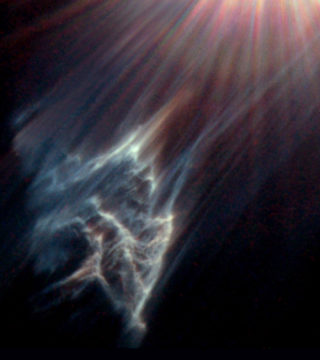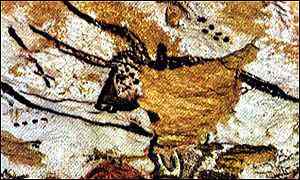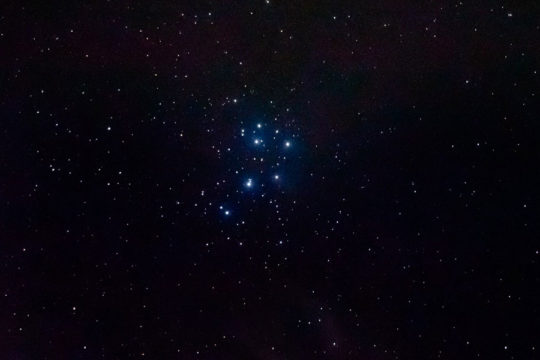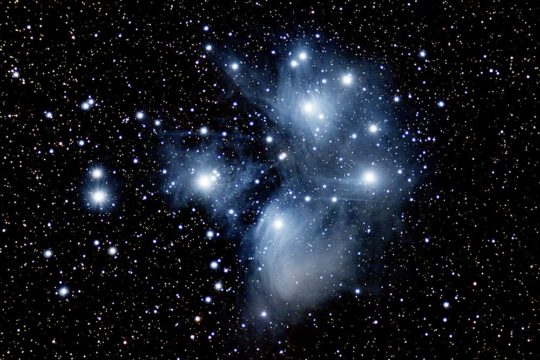Vitals
| Official name | The Pleiades |
| Other designations | M45, Cl Melotte 22 |
| Nicknames | Seven Sisters |
| Apparent magnitude | 1.6 |
| Distance from Earth | 444 light-years |
| Type | Open star cluster |
| Mass | 800 M☉ |
| Size | The central region spans 8 light-years, but the whole cluster is 43 light-years wide. |
| Constellation | Taurus |
| Right Ascension | 3h 47m 0s |
| Declination | +24° 07' 00'' |
Physical Characteristics
Perhaps no other star cluster has the fame of the Pleiades. Brilliant, easy-to-find, and a staple of winter stargazing, the Pleiades never fail to impress. Once you’ve located them for the first time, you’ll always remember them.
The Pleiades cluster is rich with stars — certainly 1,000, perhaps more than 3,000. About a quarter of these are brown dwarfs, though these “failed stars contribute only 1 or 2% to the total mass. But only a large handful of stars are bright enough to see without optical aid, and it’s these brighter stars that most people are referring to when they say “the Pleiades.”
These prominent members are bluish main-sequence stars, most of them of B-type, with magnitudes varying from about 3.0 to 6.0. They are extremely luminous, far outshining the Sun. In fact, if you could stand near the Pleiades and look back, the Sun would be only 10th-magnitude, requiring a good pair of binoculars or a small telescope to see.
The stars of the Pleiades are gravitationally bound. As such, they move through space as a cohesive group, at roughly the same speed and in roughly the same direction, so their relative positions remain stable. The effect is like multiple lanes of traffic all moving together at the speed limit. But the Pleiades is an open cluster, and the stars will likely drift apart in the future.
The Pleiades are also surrounded by a nebulosity of interstellar dust and gas. This material would ordinarily be invisible to us, but it’s illuminated by the stars in what’s known as a reflection nebula. The nebula is bluish-white, caused by a light scattering effect not unlike the one that colors Earth’s sky blue. Its wavy, diffused appearance comes in part from interactions between the nebula and the stars’ magnetic fields.

NASA / Hubble Heritage Team (STScI / AURA); Acknowledgment: George Herbig & Theodore Simon (Univ. of Hawaii)
How far away are the Pleiades? Until recently, that wasn’t so easy to answer. Historically, estimates had put the Pleiades’ distance at 400 light-years or so. Then in 1997 the Hipparcos satellite re-measured the star’s distance using its parallax. This 10%-closer distance had far-reaching implications for cosmology models. However, later Hubble Space Telescope observations suggested the Hipparcos estimates were in error. Now, astronomers have more precisely estimated the distance to be 444 light-years.
Origin / Mythology
As obvious as the Pleiades are, it should come as no surprise that ancient societies worldwide recognized the cluster and wove it into their cultures — sometimes describing six stars, sometimes seven. In fact, ancient humans (probably) depicted the Pleiades in cave paintings at Lascaux, France, representing the cluster as a series of painted dots near a large bull, which is presumably Taurus. The earliest written reference, however, is likely a Chinese record dating to 2300 BC.

French Ministry of Culture
The Pleiades also appear three times in the Bible, once in the book of Amos (“Seek him that maketh the seven stars. . .”), and also twice in the book of Job: (“Canst thou bind the sweet influences of Pleiades. . .”)
The cluster’s modern name, however, is Greek — along with the “Seven Sisters” nickname, and the names of the most prominent stars: Electra, Taygete, Maia, Celaeno, Alcyone, Sterope, and Merope. In Greek lore, these seven sisters were the daughters of Atlas and Pleione. The Pleiades name is derived from the name of the mother, Pleione, which in turn probably means “sailing” or “many/plenty.” The sailing reference might refer to the helical rising of the Pleiades, which coincided with fine nautical weather in the Mediterranean. In Homer’s Odyssey (700 B.C.), the hero Odysseus uses the Pleiades as a navigational beacon:
“. . .gladly did [Odysseus] spread his sail before [the wind], while he sat and guided the raft skillfully by means of the rudder. He never closed his eyes, but kept them fixed on the Pleiades. . .”
Several native North American groups also conceived of the Pleiades as a group of women, but other legends abound.
Another common concept held the Pleiades to be birds. In rural European areas for example, the cluster was often called “The Hen” or “The Hen with Her Chicks.” Some European cultures and Native Americans alike saw the Pleiades as being a hole that showed the light from the heavens.
How to See the Pleiades

Daniel Johnson
For convenient evening viewing, late fall and winter are the prime times for seeing the Pleiades; by January, the cluster rides high in the sky. The Pleiades are first in a line of three brilliant winter objects that rise one after the other, over the course of about six hours. The Pleiades rise first, followed by Orion, and finally Sirius.
You don’t need optical aid to see and appreciate the Pleiades. Depending on your eyesight, the cluster will appear as anything from a vague misty patch to seven or more individual stars. Some viewers with excellent vision see twelve or more. But grab a pair of binoculars to observe the cluster and you’ll be amazed. At low power, the Pleiades glow — with bright stars popping into definition, you’ll see many more than with your eyes alone.
The core of the cluster is only about 15 light-years across. This is a fun thing to keep in mind when you’re observing the Pleiades — with a single, brief movement, your line of sight traverses the distance that light takes more than a decade to travel. The feeling is akin to what astronauts felt when they looked at Earth and saw both sides of the Atlantic at once.
Viewing the basic structure of the surrounding reflection nebula is possible with a telescope but becomes more apparent via photography. A good DSLR with even a short telephoto lens will yield an image of the nebula — particularly around Merope. Hobbyists with quality astrophotography gear will obtain even better results. Use the glorious Hubble image for inspiration, and also to help you understand the fine details of the reflection nebula so that you know exactly what you’re looking for.

Richard Tabbutt / S&T's Online Photo Gallery
 1
1










Comments
Manw
November 9, 2020 at 2:42 pm
Hi there
Does anyone know exactly which night the Pleiades reach their zenith point? (UK location) Think it's usually round 21st November (though leap year might make it 20th?) Anyone got a qualified answer? Thanks
You must be logged in to post a comment.
You must be logged in to post a comment.